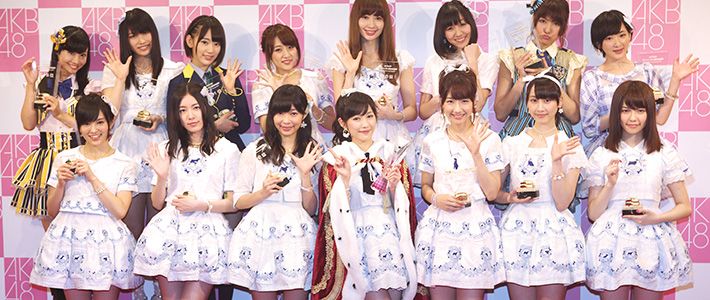
AKB48: The Return of Idol Music and the Rise of the Superfan
Culture- English
- 日本語
- 简体字
- 繁體字
- Français
- Español
- العربية
- Русский
Idol pop phenomenon AKB48 hit the news in two very different ways over the past few months. The first was a vicious and unexpected attack on group members Kawaei Rina and Iriyama Anna at a May 25 meet-and-greet event in Iwate Prefecture by a man wielding a 50-centimeter saw. The second was the altogether more choreographed and celebratory spectacle of the group’s annual “election,” which determines the lineup for the next single and the group’s next “leader”—a position claimed by Watanabe Mayu during the June 7 event.
Both these events, however, reveal different facets of a conflict that lies at the heart of the group’s business model, and indeed that of Japanese idol culture in general.
Idol Culture: Rise, Fall, and Resurgence
First, a bit of history. Idols were the big stars of the economic boom times of the 1980s. Shining bright among their ranks were the saucy Koizumi Kyōko, sophisticated Nakamori Akina, and iconic Matsuda Seiko. Their popularity and public profiles were driven as much by their commercial endorsements as by their music, and the concept of the “CM idol,” labeled with the Japanese term for television commercials, was very much grounded in the 1980s. The decade also saw the appearance of the first “mass idol” group, Onyanko Club, which included more than 50 members during the relatively short course of its activity. This group was produced by one Akimoto Yasushi.
The 1990s, on the other hand, saw idol culture move underground. These years were the age of J-Pop, and fans wanted more grown-up stars, more casual fashion, more band-oriented music. In the 1990s, idol music in its classic form was dead as a mainstream phenomenon. Idol singers and groups still existed, but they had become absorbed into otaku subculture, cultivating smaller but more dedicated fan bases.
The idol revival kicked off in earnest in 1999 with the hit “Love Machine” by Morning Musume, a group based around the same mass-idol template as Onyanko Club. Akimoto’s re-emergence on the music stage with AKB48 a few years later sealed the return of idol culture as the dominant pop cultural phenomenon of the 2000s. He accomplished this by combining the rampant commercialism of the 1980s with the underground fan culture model of the 90s.
Forming Intimate Ties with Superstars
The post-1990s idol revival has coincided with 15 years of near unbroken decline in music sales generally. Part of AKB48’s success has come from an ability to squeeze greater and greater amounts of money out of a declining market. A trade-off is made between the group and the fans in a bargain where the latter spend increasing amounts of money on CDs and other goods in exchange for access and proximity to the group members. Despite their stadium-filling success, AKB48 still maintain a 200-capacity theater in Akihabara where members of the group continue to put on shows for fans lucky or dedicated enough to have qualified for tickets.
It’s this carefully maintained illusion of intimacy between the group and the fans, with its roots in idol music’s underground 1990s days, that lies at the heart of the “handshake greeting,” where fans who buy CDs and merchandise can queue up to meet their favorite members. It was at one of these meetings that the May 25 saw attack, carried out by a 24-year-old man, took place.
The mass spectacle of the AKB48 “election” is another facet of this relationship between group and fans. A ticket entitling you to one vote is included with one of the group’s singles. The more CDs you buy, the more votes you get. AKB48 single sales typically jump by about 50% during election month. Again, the purpose of the election is to foster a sense of connection between the fans and the group, with money here traded for influence over the girls’ careers. It allows fans to feel that they are contributing to the group’s development even as their success makes them increasingly remote.
Power in the Hands of Fans
To outsiders, this relationship often seems fraught with a sort of barely repressed sexual tension. There’s certainly enough of that to support a series of video game dating simulators featuring members of AKB48 and their sister groups. The way the elections appear to encourage fans to view the girls as property, to be rewarded and punished according to how they may have pleased or displeased their masters, can seem rather disturbing. However, it’s also true that a lot of the appeal of AKB48 and any number of other idol groups lies in their chaste (although admittedly ruthlessly monetized) role as avatars providing an outlet, or even a replacement, for the unrealized—or perhaps never even fully formed—dreams of fans.
With the increase in security in the aftermath of the Iwate attack, the sense of intimacy between group and fans has come under increased pressure. But with Google Trends continuing to show a decline in general interest in the group, maintaining the interest of these dedicated superfans will continue to be of paramount importance to the AKB48 business model.
(Originally written in English on July 31, 2014. Banner photo: The 16 AKB48 members voted as most popular in the group’s recent election. © Jiji Press.)